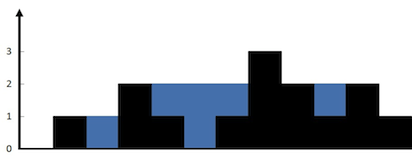Problem Statement
(Source) Given n non-negative integers representing an elevation map where the width of each bar is 1, compute how much water it is able to trap after raining.
For example,
Given [0,1,0,2,1,0,1,3,2,1,2,1], return 6.

The above elevation map is represented by array [0,1,0,2,1,0,1,3,2,1,2,1]. In this case, 6 units of rain water (blue section) are being trapped. Thanks Marcos for contributing this image!
Tags: Array, Stack, Two Pointers.
Solution - Two Pointers
The idea is very simple. Begin scan from beginning and end of array. Compare value of left and right pointer, hold the greater one and move the other to inner array. Compute passed area when pointer gets inner. (mo10)
class Solution(object):
def trap(self, height):
"""
:type height: List[int]
:rtype: int
"""
if not height or len(height) < 3:
return 0
res = 0
n = len(height)
left, right = 0, n - 1
lower = min(height[left], height[right])
while left < right:
if height[left] < height[right]:
lower = max(lower, height[left])
res += (lower - height[left])
left += 1
else:
lower = max(lower, height[right])
res += (lower - height[right])
right -= 1
return resComplexity Analysis:
- Time Complexity: O(n) .
- Space Complexity: O(1) .










 本文介绍了一种使用双指针技术解决雨后积水问题的方法。给定一个数组表示地形的高度,算法通过比较左右两侧的高度来计算能容纳多少雨水。此算法时间复杂度为O(n),空间复杂度为O(1)。
本文介绍了一种使用双指针技术解决雨后积水问题的方法。给定一个数组表示地形的高度,算法通过比较左右两侧的高度来计算能容纳多少雨水。此算法时间复杂度为O(n),空间复杂度为O(1)。
















 951
951

 被折叠的 条评论
为什么被折叠?
被折叠的 条评论
为什么被折叠?








